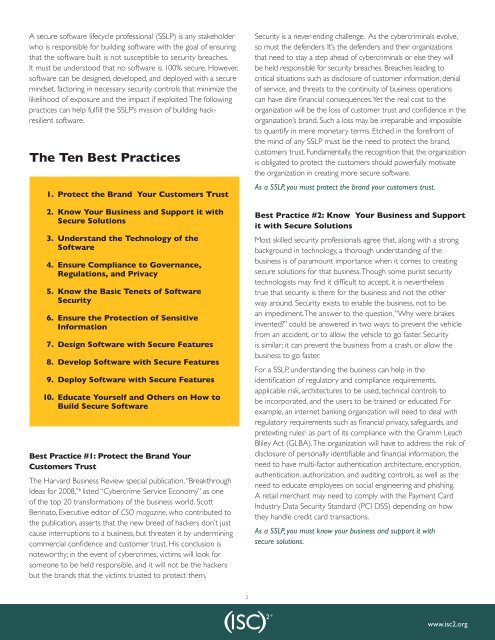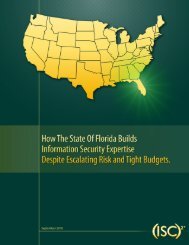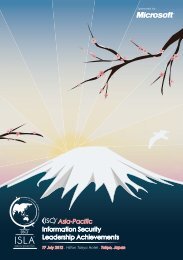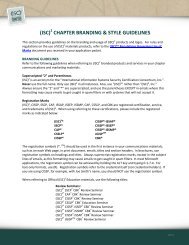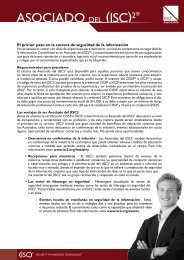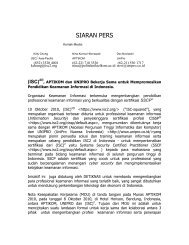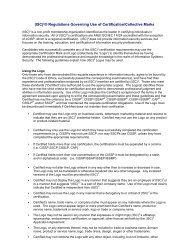The Ten Best Practices for Secure Software Development - ISC
The Ten Best Practices for Secure Software Development - ISC
The Ten Best Practices for Secure Software Development - ISC
Create successful ePaper yourself
Turn your PDF publications into a flip-book with our unique Google optimized e-Paper software.
A secure software lifecycle professional (SSLP) is any stakeholder<br />
who is responsible <strong>for</strong> building software with the goal of ensuring<br />
that the software built is not susceptible to security breaches.<br />
It must be understood that no software is 100% secure. However,<br />
software can be designed, developed, and deployed with a secure<br />
mindset, factoring in necessary security controls that minimize the<br />
likelihood of exposure and the impact if exploited. <strong>The</strong> following<br />
practices can help fulfill the SSLP’s mission of building hackresilient<br />
software.<br />
<strong>The</strong> <strong>Ten</strong> <strong>Best</strong> <strong>Practices</strong><br />
1. Protect the Brand Your Customers Trust<br />
2. Know Your Business and Support it with<br />
<strong>Secure</strong> Solutions<br />
3. Understand the Technology of the<br />
<strong>Software</strong><br />
4. Ensure Compliance to Governance,<br />
Regulations, and Privacy<br />
5. Know the Basic <strong>Ten</strong>ets of <strong>Software</strong><br />
Security<br />
6. Ensure the Protection of Sensitive<br />
In<strong>for</strong>mation<br />
7. Design <strong>Software</strong> with <strong>Secure</strong> Features<br />
8. Develop <strong>Software</strong> with <strong>Secure</strong> Features<br />
9. Deploy <strong>Software</strong> with <strong>Secure</strong> Features<br />
10. Educate Yourself and Others on How to<br />
Build <strong>Secure</strong> <strong>Software</strong><br />
<strong>Best</strong> Practice #1: Protect the Brand Your<br />
Customers Trust<br />
<strong>The</strong> Harvard Business Review special publication, “Breakthrough<br />
Ideas <strong>for</strong> 2008,” b listed “Cybercrime Service Economy” as one<br />
of the top 20 trans<strong>for</strong>mations of the business world. Scott<br />
Berinato, Executive editor of CSO magazine, who contributed to<br />
the publication, asserts that the new breed of hackers don’t just<br />
cause interruptions to a business, but threaten it by undermining<br />
commercial confidence and customer trust. His conclusion is<br />
noteworthy; in the event of cybercrimes, victims will look <strong>for</strong><br />
someone to be held responsible, and it will not be the hackers<br />
but the brands that the victims trusted to protect them.<br />
2<br />
Security is a never-ending challenge. As the cybercriminals evolve,<br />
so must the defenders. It’s the defenders and their organizations<br />
that need to stay a step ahead of cybercriminals or else they will<br />
be held responsible <strong>for</strong> security breaches. Breaches leading to<br />
critical situations such as disclosure of customer in<strong>for</strong>mation, denial<br />
of service, and threats to the continuity of business operations<br />
can have dire financial consequences. Yet the real cost to the<br />
organization will be the loss of customer trust and confidence in the<br />
organization’s brand. Such a loss may be irreparable and impossible<br />
to quantify in mere monetary terms. Etched in the <strong>for</strong>efront of<br />
the mind of any SSLP must be the need to protect the brand,<br />
customers trust. Fundamentally, the recognition that the organization<br />
is obligated to protect the customers should powerfully motivate<br />
the organization in creating more secure software.<br />
As a SSLP, you must protect the brand your customers trust.<br />
<strong>Best</strong> Practice #2: Know Your Business and Support<br />
it with <strong>Secure</strong> Solutions<br />
Most skilled security professionals agree that, along with a strong<br />
background in technology, a thorough understanding of the<br />
business is of paramount importance when it comes to creating<br />
secure solutions <strong>for</strong> that business. Though some purist security<br />
technologists may find it difficult to accept, it is nevertheless<br />
true that security is there <strong>for</strong> the business and not the other<br />
way around. Security exists to enable the business, not to be<br />
an impediment. <strong>The</strong> answer to the question, “Why were brakes<br />
invented?” could be answered in two ways: to prevent the vehicle<br />
from an accident, or to allow the vehicle to go faster. Security<br />
is similar; it can prevent the business from a crash, or allow the<br />
business to go faster.<br />
For a SSLP, understanding the business can help in the<br />
identification of regulatory and compliance requirements,<br />
applicable risk, architectures to be used, technical controls to<br />
be incorporated, and the users to be trained or educated. For<br />
example, an internet banking organization will need to deal with<br />
regulatory requirements such as financial privacy, safeguards, and<br />
pretexting rules c as part of its compliance with the Gramm Leach<br />
Bliley Act (GLBA). <strong>The</strong> organization will have to address the risk of<br />
disclosure of personally identifiable and financial in<strong>for</strong>mation, the<br />
need to have multi-factor authentication architecture, encryption,<br />
authentication, authorization, and auditing controls, as well as the<br />
need to educate employees on social engineering and phishing.<br />
A retail merchant may need to comply with the Payment Card<br />
Industry Data Security Standard (PCI DSS) depending on how<br />
they handle credit card transactions.<br />
As a SSLP, you must know your business and support it with<br />
secure solutions.<br />
www.isc2.org


